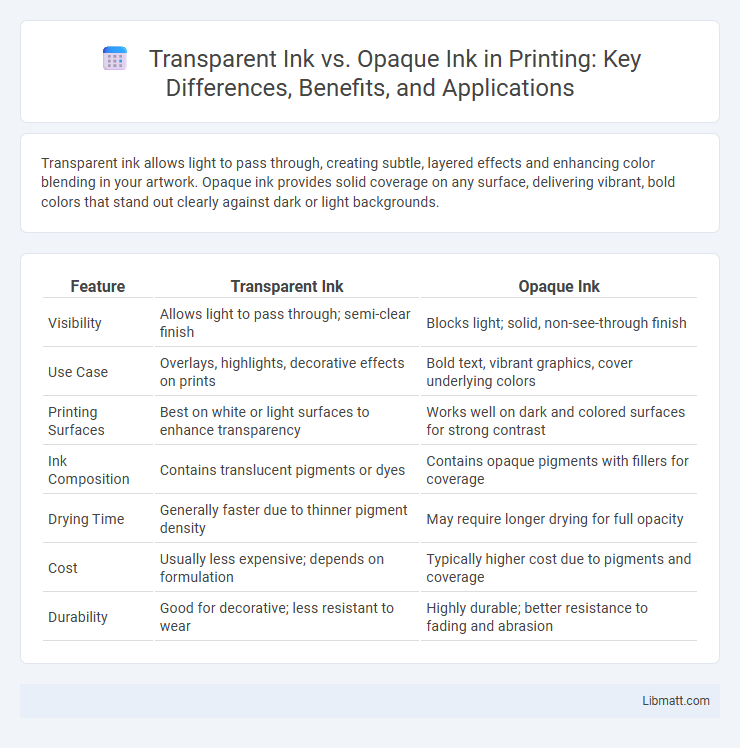Transparent ink allows light to pass through, creating subtle, layered effects and enhancing color blending in your artwork. Opaque ink provides solid coverage on any surface, delivering vibrant, bold colors that stand out clearly against dark or light backgrounds.
Table of Comparison
| Feature | Transparent Ink | Opaque Ink |
|---|---|---|
| Visibility | Allows light to pass through; semi-clear finish | Blocks light; solid, non-see-through finish |
| Use Case | Overlays, highlights, decorative effects on prints | Bold text, vibrant graphics, cover underlying colors |
| Printing Surfaces | Best on white or light surfaces to enhance transparency | Works well on dark and colored surfaces for strong contrast |
| Ink Composition | Contains translucent pigments or dyes | Contains opaque pigments with fillers for coverage |
| Drying Time | Generally faster due to thinner pigment density | May require longer drying for full opacity |
| Cost | Usually less expensive; depends on formulation | Typically higher cost due to pigments and coverage |
| Durability | Good for decorative; less resistant to wear | Highly durable; better resistance to fading and abrasion |
Introduction to Transparent and Opaque Inks
Transparent ink allows light to pass through, creating vibrant, luminous prints ideal for layering and subtle effects in designs. Opaque ink blocks light completely, providing solid, bold colors that enhance visibility and contrast on dark or textured surfaces. Understanding the difference helps you choose the right ink for your project's desired visual impact and clarity.
Key Differences Between Transparent and Opaque Inks
Transparent ink allows light to pass through, creating vibrant and layered effects ideal for glazing and overlays, while opaque ink blocks light completely, producing solid, bold colors suitable for sharp designs and high-contrast prints. Transparent inks often require multiple layers to achieve depth, whereas opaque inks provide full coverage with fewer layers. Your choice depends on whether you want luminous transparency or strong, solid color impact in your artwork.
Composition and Chemical Properties
Transparent ink contains dyes or pigments dissolved in a clear or lightly tinted binder, allowing light to pass through and providing a translucent finish ideal for layering and subtle color effects. Opaque ink uses densely packed pigments suspended in an opaque binder, blocking light to deliver solid, vibrant coverage suited for bold designs. Your choice depends on the desired visual effect and how the ink's chemical properties interact with the substrate for durability and adhesion.
Applications in Printing and Art
Transparent ink enhances printing and art by allowing light to pass through, creating subtle layering effects and vibrant color blends ideal for overlays, glazing, and mixed media projects. Opaque ink provides solid coverage, making it perfect for bold designs, text, and surfaces requiring high contrast or background masking, such as screen printing, packaging, and signage. Choosing the right ink depends on your project's desired visual impact, with transparent ink offering depth and luminosity, while opaque ink ensures vivid, standout prints.
Effects on Substrate and Material Compatibility
Transparent ink allows the substrate's texture and color to remain visible, making it ideal for applications requiring substrate visibility, such as on glass, plastic, or glossy surfaces. Opaque ink provides full coverage, masking the substrate completely, which is essential for printing on dark or colored materials to ensure vibrant and consistent color appearance. Material compatibility varies, with transparent inks often formulated for non-porous surfaces, while opaque inks suit a broader range of substrates, including wood, metal, and fabric, due to their higher pigment concentration and opacity.
Color Vibrancy and Opacity Comparison
Opaque ink delivers superior color vibrancy due to its higher pigment concentration, resulting in rich, solid hues that stand out on various surfaces. Transparent ink, characterized by its lower opacity, allows underlying materials to show through, creating translucent effects with softer color intensity. When choosing between the two, consider that opaque ink excels in bold, vivid applications, while transparent ink is ideal for layering and achieving subtle, luminous finishes.
Advantages of Transparent Ink
Transparent ink offers superior color vibrancy and layering effects due to its light-transmitting properties, enhancing artwork depth and dimension. It allows for smooth blending and subtle gradients, making it ideal for detailed illustrations and watercolor techniques. Transparent inks also dry faster and provide a glossy finish, improving durability and visual appeal on various surfaces.
Advantages of Opaque Ink
Opaque ink offers superior coverage and vibrancy on various surfaces, ensuring your designs remain bold and visible even on dark or colored backgrounds. This ink type provides excellent durability and resistance to fading, making it ideal for long-lasting prints in apparel and signage. Its ability to mask underlying colors enhances the clarity and impact of your artwork compared to transparent ink.
Challenges and Limitations
Transparent ink poses challenges in visibility and color vibrancy, making it less effective on dark or colored surfaces due to its light-transmitting properties. Opaque ink offers better coverage and durability but can result in thicker layers that may crack or peel over time on flexible materials. Your choice depends on the specific application, as transparent ink requires careful layering, while opaque ink may limit fine detail and subtle shading.
Choosing the Right Ink for Your Project
Transparent ink offers vibrant colors with a glossy finish, ideal for overlay printing and designs requiring light transmission. Opaque ink provides solid coverage, perfect for printing on dark surfaces or creating bold, high-contrast graphics. Selecting the right ink depends on the substrate, desired visual effect, and project durability requirements.
Transparent ink vs opaque ink Infographic

 libmatt.com
libmatt.com